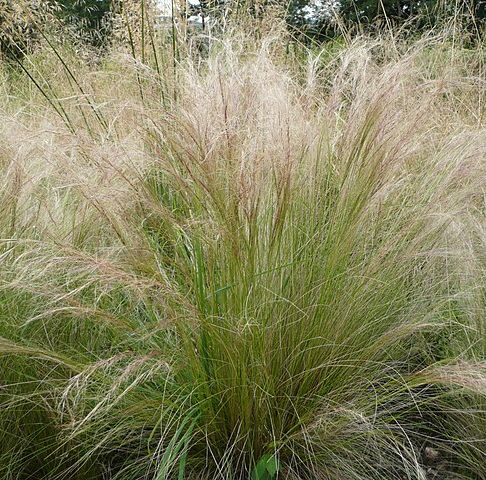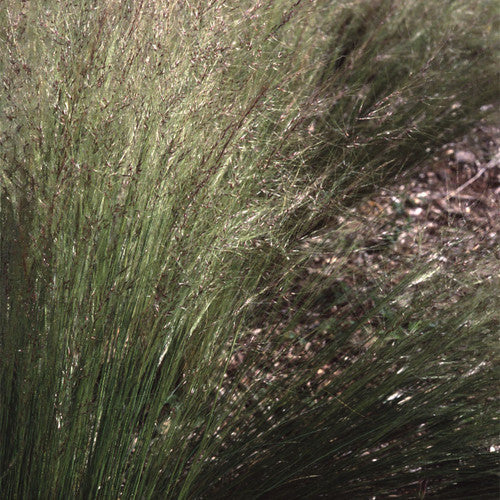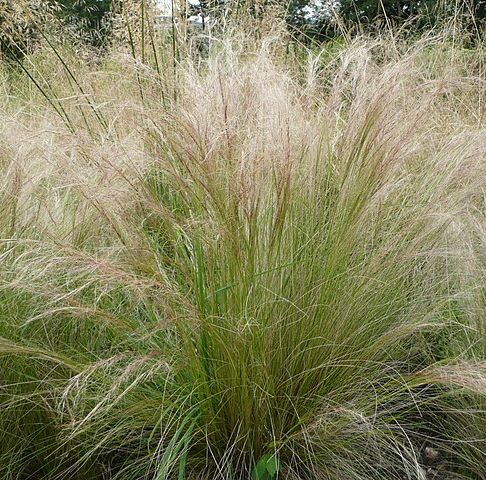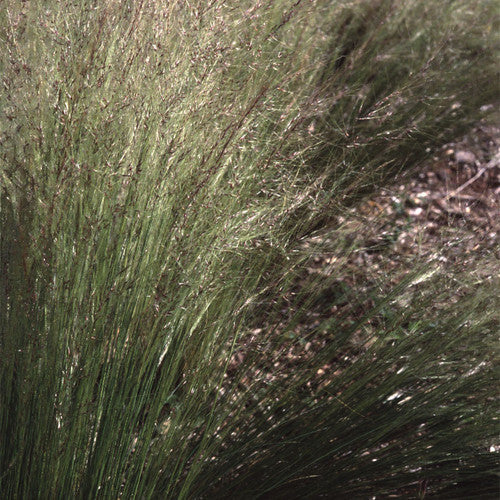Stipa tenuissima
Stipa tenuissima
Mexican feather grass
5.0 / 5.0
(1) 1 total reviews
Couldn't load pickup availability
Organic Stipa tenuissima - Mexican Feather Grass
🌿 This organic Stipa tenuissima, also known as Mexican feather grass, pony tail grass, or Texas needle grass, is a graceful and delicate ornamental grass that adds a touch of elegance and movement to any garden. This evergreen grass is native to the dry and rocky regions of Texas and Mexico, and has been awarded the Royal Horticultural Society’s Award of Garden Merit1. It is a drought-tolerant, frost-hardy, and pest-resistant plant that grows well in full sun and well-drained soil. It produces slender, arching, silvery-green leaves and fluffy, feathery flower heads in summer, which fade to a golden-brown colour in autumn and winter. Stipa tenuissima is a sustainably grown, carbon-sequestering and wildlife-friendly plant that will enhance your garden with its natural beauty and charm.
🌾 Key Features:
- Graceful, feather-like plumes that sway gently 🌿
- A delicate and airy texture for subtle beauty 🍃
- Stipa tenuissima is petite but tough
- Thrives in full sun and well-drained soil 🌞
- Low-maintor as a captivating focal point 🏡
- Transforms to a golden hue in the fall 🌾
🌞 The Details:
🌱 Flowers: Stipa tenuissima produces fine, thread-like, pale green flower panicles in summer, which turn to a golden-brown colour in autumn and winter. The flowers are airy, soft, and delicate, creating a stunning and ethereal effect in the garden. The flowers are also great for cutting and drying, as they retain their shape and colour for a long time.
🌿 Habit: Stipa tenuissima is a compact, evergreen perennial grass that grows up to 0.6 metre tall and 0.3 metre wide. It has narrow, linear, bright green leaves that are rolled or folded. The leaves sway gently in the slightest breeze, adding texture and movement to the garden.
🏡 Landscaping: Stipa tenuissima is a versatile and attractive plant that can be used in various landscaping styles and settings. It can be planted as a specimen, in groups, or in mixed borders with other perennials, shrubs, or grasses. It can also be used as a ground cover, a container plant, or an edging plant. Stipa tenuissima adds colour, contrast, and harmony to the garden, especially when the sun shines through its feathery flowers.
🌸 Low Maintenance: Stipa tenuissima is a low-maintenance plant that does not require much care or attention. It is drought-tolerant, frost-hardy, and pest-resistant. It does not need regular watering, fertilizing, or pruning. The only care it needs is to comb through the plant in spring or early summer to remove any dead or damaged growth.
🍂 Year-round Interest: Stipa tenuissima is a plant that offers year-round interest and beauty in the garden. In spring, it produces fresh and bright green leaves that contrast with the brown stems. In summer, it produces gorgeous and airy flower panicles that catch the light and the wind. In autumn, it changes colour to a golden-brown, adding warmth and richness to the garden. In winter, it retains its dried flowers and leaves, creating a striking and architectural effect in the garden. Stipa tenuissima is a plant that never fails to impress, no matter the season.
🏡 Garden Uses:
Stipa tenuissima is a plant that can be used in various ways in the garden, depending on your preference and style.
- As a focal point in a sunny border, where its height, texture, and movement will draw attention and create interest.
- Use it as a backdrop for other plants, such as perennials, shrubs, or grasses, where it will provide contrast and harmony.
- It makes good ground cover to suppress weeds
- Use it as a container plant because it is very drought resistant - no more dead plants when you get back from holiday!
- Use it as a cut flower, where it will add a foil to more showy blooms
- Use it as a dried flower, where it will last for months and years, and decorate your home, office, or craft projects.
🌱 How to Care For Stipa tenuissima
Stipa tenuissima is a very easy and rewarding plant to grow and care for:
🌞 Plant it in full sun, in a well-drained, moderately fertile soil. Avoid heavy, wet, or clay soils, as they may cause root rot or fungal diseases.
🌧️ Water it sparingly, only when the soil is dry. Do not overwater, as it may cause the plant to flop or die. Stipa tenuissima is very drought-tolerant, and can survive long periods of dryness.
🌿 Fertilise it lightly, once a year in spring, with a balanced, organic fertiliser. Do not over fertilise, as it may cause the plant to grow too fast or too tall, and lose its shape and form.
✂️ Comb through the plant in spring or early summer, using your fingers or a rake, to remove any dead or damaged growth. This will keep the plant tidy and healthy, and encourage fresh and vigorous growth.
🪴 Divide it every few years, in spring or autumn, to maintain its vigour and prevent overcrowding. Dig up the plant, and split it into smaller sections, using a sharp and clean knife or spade. Replant the sections in new locations, or share them with your friends or neighbours.
🚫 Is Stipa tenuissima Invasive?
Stipa tenuissima is not invasive, and does not pose a threat to the environment or native plants. It is a well behaved clump-forming plant and doesn't spread by rhizomes or stolons, and does not self-seed prolifically.
🌍 Carbon Sequestering Plant
Stipa tenuissima, an effective carbon sequestering plant, reduces atmospheric carbon dioxide and mitigating climate change. This natural process involves capturing and storing carbon dioxide through photosynthesis, with plants converting it into biomass. Stipa tenuissima excels in this role due to its high biomass production, longevity, slow decomposition, and deep root system which also enriches soil quality. Planting Stipa tenuissima in gardens enhances their aesthetic while contributing positively to environmental health.
🌼 Why Choose Stipa tenuissima?
Stipa tenuissima is a plant that offers many benefits and advantages for your garden and your well-being. Here are some reasons why you should choose Stipa tenuissima for your garden:
- It is a stunning and elegant ornamental grass, that adds texture, movement, and beauty to any garden.
- It is a hardy and resilient plant, that can withstand harsh conditions, such as drought, frost, and pests.
- It is a low-maintenance plant, that does not require much care or attention, and saves you time and money.
- It is a year-round plant, that provides interest and structure in every season, and never goes out of style.
- It is an organic and eco-friendly plant, that does not need any chemicals or pesticides, and helps to reduce carbon dioxide and improve soil health.
- It is a wildlife-friendly plant, that attracts and supports pollinators, birds, and other beneficial animals, and enhances biodiversity and ecosystem services.
- It is a versatile and adaptable plant, that can be used in various ways and styles, and suits any garden size and type.
🐾 Beneficial to Wildlife:
Stipa tenuissima plays a role in supporting wildlife. Similar to many ornamental grasses, it offers winter sustenance for seed-eating birds and provides shelter for small mammals and insects. Pairing it with other grassland or prairie plants can create a lovely low maintenance, drought resistant carbon sink garden that feeds and shelters wildlife and insects in your garden. 🐦
🌱 Chemical-Free Gardening:
For those committed to pollinators and insect populations, our plants are grown without the use of pesticides or herbicides. There's no risk of harmful chemical residues harming insects. Your garden can thrive naturally, nurturing a harmonious ecosystem.
🌾 Our Organic Approach
At our organic plant nursery, we are committed to providing you with the highest quality and healthiest plants, while respecting and protecting the environment and nature. We follow organic principles and practices:
- Using only natural and organic fertilisers and certified organic compost, that nourish the soil and the plants, and do not harm the wildlife or the water sources.
- Avoiding any synthetic or chemical pesticides, herbicides, or fungicides that may damage the plants, the soil, or the ecosystem, and opting for natural and biological methods of pest and disease control like companion planting, barriers and beneficial insects.
♻️ Eco-friendly Plants:
I'm deeply committed to environmental sustainability and eco-conscious practices. In our efforts to promote a greener planet, all our plants are carefully potted in biodegradable wood fibre pots or sustainably harvested from wooden troughs. This approach significantly minimises waste and plastic pollution, aligning with our philosophy of reducing our ecological footprint. We use the lowest carbon footprint delivery available (Royal Mail) and then offset the already low carbon emission of the delivery. This means that for every delivery made, we invest in environmental projects to balance out the carbon emissions generated, contributing to a more sustainable and eco-friendly experience for our customers. By choosing our services, you are not only enhancing your space with beautiful greenery but also actively participating in an initiative that cares for and respects our planet.
Plant care guide
Plant care guide
How do you plant ornamental grasses?
Dig a hole slightly larger than the rootball size, but no deeper. Most grasses like to stay on the drier side (check plant details), so if your soil is a bit heavier than ideal make the hole slightly shallower than the root ball so the surface of the rootball sits proud of the ground and ad organic matter around the circumference in a berm to sop water pooling
Water the hole and if the plant rootball doesn't seem moist pre-soak the hessian contained rootball until it is saturated (no more bubbles rise to the surface).
There is normally no need to add compost to the hole if you have an established garden with healthy plants already growing. If you have a newbuild property or poor growth to existing plans chances are that your whole fowerbed needs improving with organic matter. If you have heavy soil grasses some may struggle so consider topdressing plenty of organic matter over a few years before choosing grasses.
Place the rootball in the hole. You can remove the hessian sacking it came in, or just remove the staple/twine and open the top once it's in the ground so the plant is free. The roots will easily grow through and the hessian will decompose. Back fill the surrounding area with the dug soil. Do not firm the soil down hard! Roots need air and water and hard compacted soil prevents them from getting both.
Once planted water the plant in well and then water again whenever the soil starts to dry out under the surface for the first year. Be careful not to overwater.
Mulching with something like woodchips around the plant after watering will help the soil to retain the moisture in hot weather. Perennial's Grasses ofen have deciduous foliage that will die off in the winter - this can be left up as looks attractive and also provides a habitat for overwintering insects.
When to plant ornamental grasses in the UK?
Perennial plants can be planted out in the garden or in pots from spring, through the summer, to the autumn. During dry weather and especially during the summer much closer attention needs to be given to watering in the first year.
If planting in hot weather, cut the foliage and flowers back. Your new plant will not be taking up much water until established so may struggle if the leaves lose more water than the roots can absorb. For the strongest result do not allow to flower or at least to set seed in the first year.
Where to plant ornamental grass?
Check the plant info at the bottom of the page for the best place to position your new plant. If it prefers sun and you plant it in a north facing flowerbed next to a wall don't expect it to thrive or flower.
Pay attention to the soil. If it is heavy clay, incorporate organic matter such as compost to the soil before planting your grass, preferably to the whole flowerbed. This will improve the soil by buffering it's water and nutrient holding ability. It is preferable to not just plonk compost in the bottom of the hole as it will not improve the overall condition of the soil surrounding your new plant. Do not add a layer of gravel or grit to the bottom of the hole as this will merely cause the perched water table to be higher. It will not improve drainage.
How do you care for perennial grasses?
Cut back untidy foliage in the spring (you can leave the clippings on the flower bed to allow the nutrients to recycle into the soil). Divide every 3 to 5 years as the centre dies out and replant your extra plants! Perennial grasses come back every year. Some are longer living than others.
Should ornamental grasses be fertilised?
The vast majority of garden soils contain plenty of nutrients, but if your garden is in a newly built development there is a good chance a thin layer of topsoil has been added on top of infertile subsoil. if that is the case, compost, soil improver or well rotted manure can be spread on the flower bed and dug in, or alternatively for those short of time or energy, organic fertiliser such as our own special organic mix of bone meal, hoof and horn and vinaase that is an organic, sustainable alternative to the John Innes formula, can be sprinkled around the plant with some compost added to the planting hole.
Delivery £5 flat rate or FREE over £50 spend.
Delivery £5 flat rate or FREE over £50 spend.
I charge a flat rate of £5 for postage and packaging to all of Britain, including the Highlands and the Isle of Man, with free delivery for orders over £50. We are unable to send plants to Northern Ireland.
I use Royal Mail for our deliveries as they have the lowest carbon footprint per parcel delivered in the UK and actually tend to look after parcels rather than just chucking them over the nearest fence! This ensures that your plants will have the best care possible.
Please have a Safe Place set up if possible so your plants are not returned to the sorting office if no one is home to accept the delivery.
I try to dispatch plants twice a week and you will receive updates by text or email. In cases of extreme weather or if Royal Mail has a hiccup the delivery may be delayed but we'll keep you in the loop.
I'm unable to deliver to the Channel Islands or Northern Ireland.
The LAWNMOWER Guarantee
The LAWNMOWER Guarantee
Healthy plants & happy customers
Your plant will only be dispatched if I'm happy it is healthy. The nature of growing the plants in large troughs means that the root system will be trimmed before they are balled in hessian, and therefore, depending on the time of year, the top growth may also be trimmed to make sure the roots are able to supply the water and nutrients your new plant requires.
Pruning encourages new growth and this applies to roots as well so a pruned plant actually results in a stronger plant.
The LAWNMOWER guarantee.
If you're not happy with your plants for any reason, even if you've run them over with your lawnmower, just pop them in a box (the plants, not the mower!) and post them back to us within 1 year for a replacement or refund.
This does not affect your statutory rights.
For full details check out the Refunds and Returns Policy.
Sustainability
Sustainability
Eco-friendly business
Fed up with plants grown in plastic pots which are doused in herbicides and sprayed with synthetic chemicals by big nurseries who merrily burn through finite resources, fly plants in from abroad on jet planes, irresponsibly use peat and coir, kill any insect nearby with non-selective pesticides and generally only think of the bottom line?
So are we!
How we grow plants sustainably
Our plants are started in coldframes or inside our house, grown-on woodfibre pots or in reclaimed wooden troughs which are then carefully harvested and balled and burlapped (hessian wrap securing the rootball), before packing plastic free in a eco cardboard box from a certified B-corp carbon neutral supplier. Some plants are grown in 8cm woodfibre pots.
Sustainable and organic compost & fertiliser
Our Soil Association certified organic compost is bought in bulk without plastic bags from Dalefoot Compost, and consists of sheep wool, bracken and comfrey. This naturally feeds the plants for 12 months. If supplemental feeding is required we only use our own special blend of organic fertilisers (bone meal, hoof & horn and vinaase) which have been processed with solar energy.
Carbon Neutral business
The small amount of electricity we use is from renewable sources and we irrigate our plants with stored water we have harvested. Plus, we are using our house and land for more than one purpose, preventing further land use and utilising the sunk carbon cost of the building rather than creating more.
We have partnered with Carbon Neutral Britain to offset our emissions, and recognise that we are not in control of all parts of the supply chain so have fully offset scopes 1, 2 and 3 to take that in to account - so that's all emissions connected to our business, from the farts coming out of the back of the sheep, to the carbon dioxide from the delivery van outside your door.
We don't just offset and carry on, ALL the decisions we make work to reduce emissions - for instance we use Royal Mail to post our plants as they have by far the lowest carbon footprint per parcel delivered in the UK.
Stipa tenuissima (syn.Tenuifolia)
View full details

Really good communication and very pleased with the quality of plants delivered. Many thanks.


